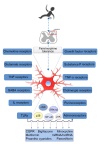Regulatory mechanisms and therapeutic potential of microglial inhibitors in neuropathic pain and morphine tolerance
- PMID: 32133798
- PMCID: PMC7086010
- DOI: 10.1631/jzus.B1900425
Regulatory mechanisms and therapeutic potential of microglial inhibitors in neuropathic pain and morphine tolerance
Abstract
Microglia are important cells involved in the regulation of neuropathic pain (NPP) and morphine tolerance. Information on their plasticity and polarity has been elucidated after determining their physiological structure, but there is still much to learn about the role of this type of cell in NPP and morphine tolerance. Microglia mediate multiple functions in health and disease by controlling damage in the central nervous system (CNS) and endogenous immune responses to disease. Microglial activation can result in altered opioid system activity, and NPP is characterized by resistance to morphine. Here we investigate the regulatory mechanisms of microglia and review the potential of microglial inhibitors for modulating NPP and morphine tolerance. Targeted inhibition of glial activation is a clinically promising approach to the treatment of NPP and the prevention of morphine tolerance. Finally, we suggest directions for future research on microglial inhibitors.
Keywords: Microglia; Neuropathic pain (NPP); Morphine tolerance; Microglial inhibitor.
Conflict of interest statement
Figures

Similar articles
-
Modulation of microglia can attenuate neuropathic pain symptoms and enhance morphine effectiveness.Pharmacol Rep. 2008 May-Jun;60(3):297-307. Pharmacol Rep. 2008. PMID: 18622054 Review.
-
Minocycline can delay the development of morphine tolerance, but cannot reverse existing tolerance in the maintenance period of neuropathic pain in rats.Clin Exp Pharmacol Physiol. 2015 Jan;42(1):94-101. doi: 10.1111/1440-1681.12316. Clin Exp Pharmacol Physiol. 2015. PMID: 25311407
-
Shanzhiside methylester, the principle effective iridoid glycoside from the analgesic herb Lamiophlomis rotata, reduces neuropathic pain by stimulating spinal microglial β-endorphin expression.Neuropharmacology. 2016 Feb;101:98-109. doi: 10.1016/j.neuropharm.2015.09.010. Epub 2015 Sep 9. Neuropharmacology. 2016. PMID: 26363192
-
Metformin reduces morphine tolerance by inhibiting microglial-mediated neuroinflammation.J Neuroinflammation. 2016 Nov 17;13(1):294. doi: 10.1186/s12974-016-0754-9. J Neuroinflammation. 2016. PMID: 27855689 Free PMC article.
-
Importance of glial activation in neuropathic pain.Eur J Pharmacol. 2013 Sep 15;716(1-3):106-19. doi: 10.1016/j.ejphar.2013.01.072. Epub 2013 Mar 13. Eur J Pharmacol. 2013. PMID: 23500198 Review.
Cited by
-
Current and Evolving Concepts in the Management of Complex Regional Pain Syndrome: A Narrative Review.Diagnostics (Basel). 2025 Feb 3;15(3):353. doi: 10.3390/diagnostics15030353. Diagnostics (Basel). 2025. PMID: 39941283 Free PMC article. Review.
-
The Melatonin Type 2 Receptor Agonist IIK7 Attenuates and Reverses Morphine Tolerance in Neuropathic Pain Rats Through the Suppression of Neuroinflammation in the Spinal Cord.Pharmaceuticals (Basel). 2024 Dec 5;17(12):1638. doi: 10.3390/ph17121638. Pharmaceuticals (Basel). 2024. PMID: 39770480 Free PMC article.
-
Focus on P2X7R in microglia: its mechanism of action and therapeutic prospects in various neuropathic pain models.Front Pharmacol. 2025 Mar 25;16:1555732. doi: 10.3389/fphar.2025.1555732. eCollection 2025. Front Pharmacol. 2025. PMID: 40201695 Free PMC article. Review.
-
Microglial inflammation modulates opioid analgesic tolerance.J Neurosci Res. 2023 Sep;101(9):1383-1392. doi: 10.1002/jnr.25199. Epub 2023 Apr 26. J Neurosci Res. 2023. PMID: 37186407 Free PMC article. Review.
References
Publication types
MeSH terms
Substances
LinkOut - more resources
Full Text Sources

